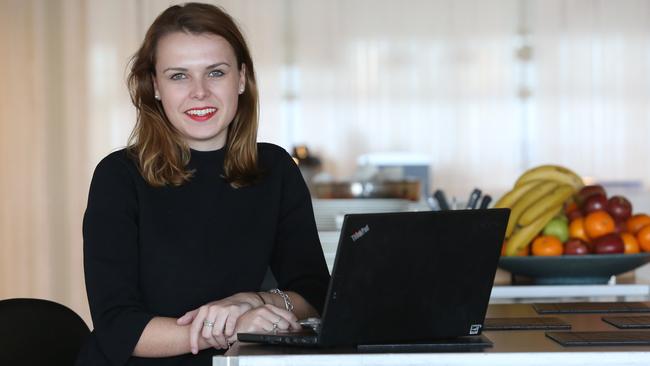Video resumes and interviews: welcome to the brave new world
No need to come in for a job interview, just send in your video resume.

Welcome to the brave new — and impersonal — world of video resumes and interviews.
Companies such as KPMG and PricewaterhouseCoopers increasingly are turning to technology to find progressive candidates and graduates, differentiating them from those who fail to move with the times.
US-based tech company Software Advice undertook a survey earlier this year to find 60 per cent of hiring managers and recruiters in the US are using some form of video interviewing, whether it be live or recorded questions.
Their survey of 400 people found 47 per cent preferred video interviews to phones.
While in its infancy in Australia, more companies are likely to follow the trend and recruitment experts are already offering advice on how to make a video resume or response to a video questionnaire that stands out from the crowd.
There are obvious pitfalls, such as failing to come across as professional, inappropriate choice of work wear, bad video backgrounds and not looking directly into the camera. Career Consultancy’s Catherine Cunningham says it may take a few practice goes to get the resume right.
“If someone came to me for advice on a video resume I’d say they need to have structure and come across as appealing and technically sound in their knowledge,” Cunningham says.
“It’s essentially the rules of public speaking. Tell them what you’re going to tell them, then tell them, then tell them what you told them.”
Cunningham advises people to include three elements in a video resume: tell the company something about themselves, what they do outside work, such as volunteering, and why they would make a good accountant, lawyer or whatever the position may be.
Companies also are turning to video interviewing, with questions sent to shortlisted candidates with spaces inserted for replies.
This allows companies to save time by not having to organise a panel to interview people directly, and they can quickly weed out candidates who fail to provide adequate responses.
“They’re difficult because there are no facial cues,” Cunningham says.
“There are cost and time savings because they only have to conduct that one interview instead of 100 times.”
Earlier this year, KPMG used video interviews as part of its graduate program application process, in conjunction with a new gamification exercise, a values survey and a cultural component.
More than 10,000 people applied for the 2016 graduate intake, and about 1500 people eventually took part in the video interview round.
Each video was watched by the firm’s graduate recruitment team.
National managing partner Susan Ferrier says the methodology suits the graduate market.
“All of those candidates spend a lot of time using video platforms anyway, by using Skype or Snapchat in their personal lives, and it can be a lot more comfortable for them,” Ferrier says.
Head of recruitment Nikki Harrison says the new format was well received, with few people failing to complete the video question section of the application process.
As technology improves, she says, it will also spread quickly through recruitment circles. “It’s starting to become more popular in the graduate industry and where people are more comfortable with it,” she says.
Internally, the video questionnaire trial was so successful the company will continue next year, and Ferrier has been fielding questions from recruiters on how it works.
Partners are giving positive feedback and some have asked if they can use the technique when recruiting for other positions. Graduates find it less confronting and there is significant time saved for those having to sort through thousands of resumes.
Instead of bringing in graduates for a half-day’s worth of testing and interviewing — which once involved transcribing responses to face-to-face questions — fewer people are being called in and the five-minute videos can be passed to different partners.
KPMG follows the video round with face-to-face interviews.
“Instead of inviting thousands of people in for interviews, we’re inviting in about 800,” Harrison says.
Ferrier says the video interviews also have helped the company increase diversity, by being able to see different candidates and not just read their details on a page.
“It has helped us expand our view and we’re hiring graduates from different areas — we’re hiring music graduates, arts graduates — and we’re making different choices.”
Successful candidate clicked, but she says it’s not for everyone
Accounting and finance graduate Anna Brotherson is one of a new breed of job applicants who has faced the changing world of job interviews — and she has done it in her pyjamas.
This year Brotherson applied for several graduate programs and was surprised that two of the nation’s largest corporate employers, KPMG and PricewaterhouseCoopers, had requested she take part in a video interview.
“It was very good because it took the pressure off because you could read the questions and you had 30 seconds to consider your answer,” Brotherson says. “The only thing that was daunting was looking into the camera.”
In both cases Brotherson was sent a web link and a password to enable her to log on, with about a week to complete the interview. There were practice questions as well.
She found the process a “bit odd” because she prefers to speak to people face to face, but she can see how some candidates might find it easier.
She also undertook her first interview with her pyjama bottoms on and a corporate jacket on top. Realising she felt more professional when fully dressed, she did her second interview at home, in the kitchen, and dressed for work.
“You can do it at home when you’re relaxed and you’ve got flexibility, and you can do it at a time that suits you,” she says.
“It’s a little less personal but you have time to prepare.”
KPMG offered Brotherson a job in an early intake, and she started work in July.


